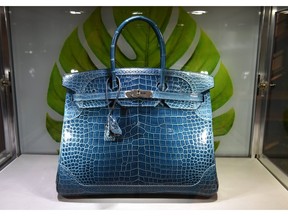While designer ‘dupes’ — whether an alternative to a trending silhouette from a more affordable brand or a full-on replica — are nothing new, they’re creating big buzz online these days.

Reviews and recommendations are unbiased and products are independently selected. Postmedia may earn an affiliate commission from purchases made through links on this page.
Designer ‘dupes’ abound on the internet.
Recommended Videos
Recently, one such counterfeit creation took social media by storm.
It had a price tag of less than US$80.
“The cost is the actual price of making an object properly, with the required level of attention, so that you have an object of quality,” Dumas explained. “Expensive is a product which is not delivering what it is supposed to deliver. But you’ve paid quite a large amount of money for it, and then it betrays you. That’s expensive.”
According to Watkins, who operates resale boutiques in Vancouver and Toronto, the appeal is anything but trendy.
“It’s about timelessness, brand history and true craftsmanship,” says Watkins. “In a world where fast fashion fades faster than a trend on TikTok, the Birkin stands still as the ultimate status symbol.”
The ‘dupe’ effect
While designer ‘dupes’ — whether an alternative to a trending silhouette from a more affordable brand or a full-on replica — are nothing new, they’re creating big buzz online these days.
What’s driving the increasing interest in fake fashion items?
“Some consumers would say it’s a protest because the luxury brands charge too much. So they purchase a counterfeit piece and they use social media to kind of make fun of the luxury brands,” Li says of the anti-corporate ideology.
But Li says it’s not just low- and mid-income shoppers who can’t afford the real thing that buy into the counterfeit movement.
“Some people can actually buy luxury brands just like playing with the counterfeit items,” Li says. “They feel they don’t need a real or authentic one to signify or symbolize their wealth.”
The consumer society, Li points out, has also become more polarized these days.
“Before, there was a hierarchy, like, you’re first purchasing high-street fashion items. And then you move up the social or the income ladder and then you purchase luxury brands,” Li says. “But nowadays, some people are sticking to those luxury brands, but some people don’t see luxury consumption as the end part of their life goal.”
And social media, the academic says, has created a space for both categories of consumers to interact.
“These groups of consumers are speaking to each other,” Li says. But, he notes, they’re not confusing one another.
“I’m pretty sure those people, no matter who they are, know they are not wearing an Hermès Birkin bag. It’s very clear that they know it’s the Walmart version of a Birkin bag,” Li says. “The style looks the same, but it’s a different kind of craftsmanship. The quality is not the same.
“And that really differentiates the luxury consumer from the ‘Wirkin’ consumer.”
Watkins also points to the “instant gratification” that counterfeit goods provide as a big draw for some shoppers purchasing fakes.
“People love the idea of scoring a Birkin look-alike at a fraction of the price — no need to save up or wait years,” Watkins says. “Imagine seeing something that screams ‘status symbol’ on a platform like Walmart, and knowing it’s now within reach.”
“You won’t see those bags in the actual Walmart store. But consumers are using the Walmart platform, like other channels such as Temu or Amazon, to purchase the products,” Li explains. “And then, more or less, picking the product up at a Walmart near you.”
Li says the degree of separation might help Walmart avoid a direct legal confrontation with the luxury brand in the long run.
“From a legal perspective, it’s a very good way of defending themselves that they are just providing a platform for these kinds of copycat products,” Li says. “It’s complicated.”
Long-term impact
Consumer motivations aside, Watkins says there’s a larger conversation to be had about the true cost of counterfeit fashion.
“Buying fake bags, especially knock-offs with the same branding, is not just about owning a cheaper alternative — it comes with serious ethical and legal concerns,” Watkins says. “These counterfeit products often support unethical labour practices and even criminal organizations. Moreover, they undermine the artistry and hard work of the original creative directors and artisans who pour their talent and dedication into creating the genuine product.
“It’s important to recognize that purchasing these fakes takes away from the value and integrity of the original designs.”
But Li says the popularity of the Walmart Birkin, in the end, will likely serve to further the sense of exclusivity and desirability around authentic Birkin handbags.
“Now, because of these social-media and TikTok conversations, it brings Hermès and other luxury brand names to everyone’s world,” Li says.